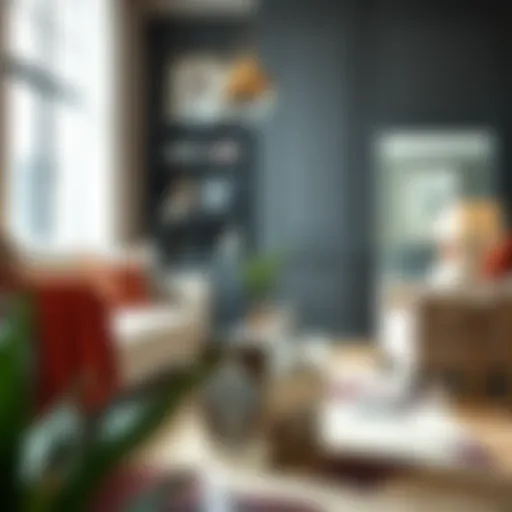Single Pantry Cabinet: Optimize Space & Functionality
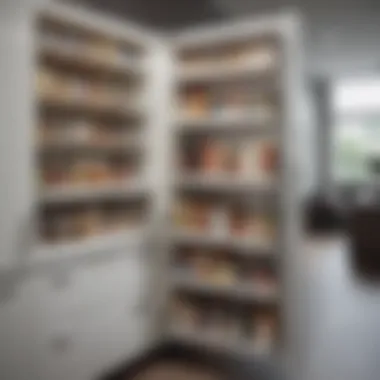

Intro
In the heart of every home, the kitchen serves as more than just a place for cooking; it’s often the hub where families gather, share stories, and create memories. A single pantry cabinet plays a pivotal role in keeping this essential space organized while simultaneously enhancing its overall aesthetic. Without a doubt, choosing the right pantry cabinet requires careful thought, considering not just functionality but also style and design. This guide aims to empower readers with the knowledge necessary to make informed decisions, thereby elevating the kitchen experience for everyone involved.
Furniture Styles and Trends
Refining the look and feel of a kitchen often begins with understanding the furniture styles that can complement the overall design of the space. When it comes to single pantry cabinets, a variety of styles can be considered, each offering unique attributes.
Exploring Popular Furniture Styles
- Modern: Clean lines and minimalistic designs characterize modern pantry cabinets. They often come in sleek finishes and can make even the smallest kitchen feel open and airy.
- Rustic: Think wood with a charm. Rustic pantry cabinets embrace natural finishes and textures, providing warmth and a cozy atmosphere.
- Traditional: These cabinets often feature intricate detailing, such as molding and raised panels, contributing a touch of elegance to any kitchen.
Each style comes with its own set of advantages, allowing homeowners to choose one that not only fits practical needs but also resonates with personal taste.
Understanding Current Design Trends
Staying current with design trends can give your kitchen a fresh look. Some trends to consider include:
- Eco-Friendly Materials: More homeowners are opting for sustainable materials such as bamboo or reclaimed wood. These options are not only stylish but also better for the environment.
- Bold Colors: While whites and neutrals remain popular, splashes of color, particularly in cabinet styling, have found their way back into kitchens, offering a modern twist.
- Open Shelving: Many people are leaning towards open shelving combined with pantry cabinets. This combination creates an illusion of space while making frequently used items easily accessible.
"The right pantry cabinet doesn't just store food; it shapes the kitchen's character and efficiency."
Practical Tips for Furniture Selection
Choosing the perfect pantry cabinet goes beyond picking a style; it involves thoughtful consideration of various factors that can impact functionality and space optimization.
Factors to Consider When Choosing Furniture
- Space Availability: Before making any purchases, assess the available space. Consider not just the cabinet footprint but also the possible need for maneuvering space around it.
- Storage Needs: Think about what you plan to store. Whether it’s bulk items, small essentials, or kitchen gadgets, different needs will dictate different cabinet designs.
- Accessibility: Ideally, you want cabinets that allow for easy access to their contents. Features like pull-out shelves can dramatically enhance usability.
How to Measure and Optimize Space
- Measurement: Take precise measurements of the area where the pantry cabinet will go. Don’t forget to account for door swings and any appliances nearby.
- Height Consideration: Depending on your kitchen height, consider taller cabinets for additional storage or lower ones if you prefer them to fit differently within your design scheme.
- Utilize Vertical Space: Don’t shy away from going vertical. Tall cabinets can maximize storage without sacrificing floor space.
Ultimately, selecting the right single pantry cabinent is about creating a functional and aesthetically pleasing kitchen. By understanding the styles, trends, and practical considerations, you can create a kitchen that reflects your lifestyle while meeting your storage needs.
The Concept of a Single Pantry Cabinet
In the realm of kitchen design, the single pantry cabinet emerges as an invaluable asset. The importance of this piece of furniture cannot be overstated; it's not merely a storage unit but rather a key player in enhancing both the aesthetic and functional aspects of the kitchen. Having a dedicated space for food, utensils, and various kitchen supplies creates an organized environment where one can operate efficiently. After all, a cluttered kitchen can become a source of stress, while a clean and well-arranged space fosters creativity and comfort.
Defining the Single Pantry Cabinet
A single pantry cabinet essentially refers to a standalone structure designed specifically for food and kitchen item storage. Unlike cabinets that are integrated into kitchen designs, these standalone units bring additional flexibility to your cooking space. They come in various sizes and configurations, making it easy to choose one that suits your specific needs.
Typically, the layout of a single pantry cabinet includes shelves for dry goods, adjustable compartments for different types of items, and perhaps even designated spaces for appliances like microwaves or mixers. Think of it as your kitchen's command center—where everything you need is at your fingertips, neatly tucked away yet easily accessible.
Historical Context of Pantry Cabinets
Understanding the historical development of pantry cabinets can shed light on their evolving role in home organization.
Centuries ago, when kitchens were largely utilitarian spaces, pantries served as larders or simply rooms for food storage. Initially, they were separate from the main kitchen area, designed primarily to keep perishables cool and organized away from the heat of cooking. These early pantries were integral to household management, reflecting a time when families grew their own food or relied heavily on preserved goods.
Over the decades, as kitchen design evolved, so too did the pantry's role. With the rise of convenience foods and modern appliances, the function of the pantry transitioned from a designated room to a dedicated cabinet.
"The evolution of the pantry, from a cool, dark room to an accessible cabinet, mirrors changes in home cooking and storage needs over time."
In contemporary kitchens, the single pantry cabinet can be a statement piece, showcasing a blend of style and practicality. Understanding its historical significance helps appreciate the modern kitchen's need for organization, efficiency, and, importantly, a touch of style.
Design Variations of Single Pantry Cabinets
When it comes to maximizing kitchen efficiency and space, the design of a single pantry cabinet is more than just an aesthetic choice; it's a functional strategy. Different design variations not only cater to individual tastes but also adapt to practical needs within the kitchen space. Understanding these variations allows homeowners and designers to make informed decisions that enhance both the style and utility of the cabinets. Factors such as space availability, style preference, and functional requirements all play a crucial role when selecting a pantry cabinet design.
Contemporary Designs
Contemporary designs in single pantry cabinets are often marked by sleek lines, minimalistic features, and a blend of functionality and form. These cabinets typically favor straightforward aesthetics, using colors like whites, blacks, or grays to create a clean look, often paired with bold accents for a modern touch.
The benefits of contemporary designs include:
- Space Efficiency: Many contemporary models utilize vertical space effectively with tall cabinets that stretch towards the ceiling.
- Built-In Organization Features: Such cabinets often incorporate built-in shelves, pull-out drawers, and other organizational tools that help keep the kitchen clutter-free.
- Materials: A mix of materials like glass, metal, and engineered wood keeps the design fresh and aligned with modern trends.
Designed for a fast-paced lifestyle, these cabinets also lend themselves well to open kitchen concepts, allowing seamless integration into the overall kitchen design while making cooking and entertaining more enjoyable.
Traditional Styles
For those who prefer a classic touch, traditional styles in single pantry cabinets offer myriad options. These cabinets usually showcase intricate details, ornate carvings, and a sense of depth in design. Made predominantly of solid wood, they may feature rich textures and hues that create warmth and character in the kitchen.
The charm of traditional styles lies in their ability to evoke nostalgia while serving modern needs. Some key features include:
- Rich Craftsmanship: The attention to detail in cabinet construction often reflects an era where handmade quality was of utmost importance.
- Versatile Finishes: Traditional styles can be stained or painted, allowing homeowners to customize the look according to their kitchen decor.
- Timeless Appeal: Even as trends change, traditional pantry cabinets maintain a classic appearance that can appeal to a wide range of tastes.
Choosing a traditional style often means selecting a piece that not only serves as a functional storage solution but also as a conversation starter in the heart of the home.
Rustic Single Pantry Cabinets
Rustic single pantry cabinets bring an entirely different flavor to kitchen architecture, embracing a more casual and earthy vibe. Often crafted from reclaimed or distressed wood, these cabinets highlight imperfections and variations in material, bringing character and warmth.
The appeal of rustic pantry cabinets encompasses several aspects:
- Natural Aesthetics: They invite a touch of nature inside, often featuring organic shapes and raw finishes that celebrate the wood's natural markings.
- Durability: Built typically from robust materials, rustic cabinets are designed to withstand the rigors of daily use while providing a robust storage option.
- Flexibility: They can easily blend in with both country-style and more modern settings, making them appropriate for various interior motifs.
Rustic cabinets can serve as a bridge between homely warmth and functionality, creating spaces where comfort and style coexist.
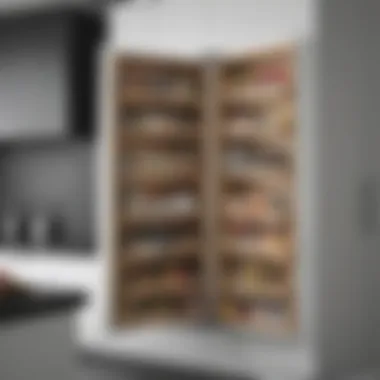

"The right pantry cabinet design does not just house ingredients; it curates the kitchen experience."
In summary, the design variations of single pantry cabinets fundamentally shape the kitchen's workflow and vibe. By considering contemporary, traditional, and rustic designs, homeowners can choose cabinets that not only serve practical storage needs but also reflect their unique style and enhance the culinary space.
Materials Used in Single Pantry Cabinets
When it comes to pantry cabinets, the materials chosen can significantly influence both functionality and aesthetic appeal. The material determines the durability, ease of maintenance, and how well the cabinet integrates with the overall kitchen design. Today's market offers a diverse array of materials, each with its own unique characteristics. Understanding these options can help homeowners and designers alike make informed decisions that will satisfy not just the eye but also the practical needs of a kitchen.
Wood: A Timeless Choice
Wood has long been the go-to material for pantry cabinets, and for good reason. There’s a certain warmth and character that only wood can provide. It doesn’t just look good; it ages beautifully. A well-crafted wooden pantry cabinet can elevate the entire kitchen's atmosphere. Moreover, wood is a versatile option that lends itself well to various styles—from traditional to modern.
- Types of Wood
Different species of wood offer varying looks and strengths. Maple, oak, and cherry are often praised for their durability and eye-catching grains.
- Maple is strong and has a fine grain, making it perfect for a smooth finish.
- Oak is very sturdy and provides a more rustic look with its pronounced grain patterns.
- Cherry tends to deepen in color, giving character over time.
A downside to wood is its susceptibility to moisture. Proper sealing and regular maintenance are necessary to prolong its life. However, many people find the upkeep worth it because of the rich aesthetic it brings to a kitchen.
Metal Options for Modern Aesthetics
For those leaning towards a contemporary vibe, metal pantry cabinets have gained popularity. Stainless steel, aluminum, and even certain alloys can impart a sleek, industrial look that resonates with modern tastes. These materials are not only chic but also come with various functional benefits.
- Durability
Metal is less prone to warping or cracking compared to wood. This makes it a favorite in high-traffic kitchens where wear and tear is inevitable. - Maintenance
They require less upkeep. A simple wipe-down is usually sufficient, making them practical for busy homeowners.
However, metal cabinets can feel cold and sterile, which might not suit everyone's taste. Blending these materials with wooden elements or warm colors can strike a balance between style and comfort.
Composite Materials and Their Benefits
Composite materials, such as medium-density fiberboard (MDF) and particle board, offer another alternative. They are made from wood fibers and resin, which are compressed and bound together. This results in a cost-effective solution that doesn’t skimp on quality.
- Cost-Effectiveness
Composite materials are typically more affordable than solid wood or metal options. This makes them an attractive choice for homeowners on a budget. - Versatility
They can be easily finished or painted, allowing for creativity in design. You can even replicate the look of more expensive materials without breaking the bank.
However, like wood, composites may not fare well in damp conditions unless treated properly. They are generally not as strong as solid wood or metal, so understanding their limitations is key before making a choice.
In summary, the materials used in single pantry cabinets play a crucial role in determining their longevity, aesthetic appeal, and functionality. Careful selection based on lifestyle and kitchen design will yield cabinets that not only meet storage needs but enhance the overall environment.
Functionality and Features
When it comes to home organization, the words "functionality" and "features" ring out louder than a church bell on Sunday morning. A single pantry cabinet isn't just a pretty facade in the kitchen; its real power lies in its ability to streamline the chaos of culinary life. It’s not merely a box for storage; it can morph into a multifaceted ally that breathes order into an otherwise cluttered space. The importance of understanding its functionality is paramount for homeowners, interior designers, and renovators alike.
Interior Organization Solutions
One of the primary benefits of a single pantry cabinet is its interior organization solutions. It’s like having your very own logistics manager right in your kitchen. Think of how often you rummage through piles of products—searching for that elusive jar of marinara or a forgotten bag of quinoa. A well-structured pantry cabinet can save you from that culinary scavenger hunt.
- Baskets and Bins: Using labeled baskets allows you to categorize items. Dry goods, snacks, and often-used cooking ingredients can be easy to find. When your items are organized, making meals becomes an effortless task, as you’ll know where everything is, eliminating unnecessary frustration.
- Pull-Out Organizers: These nifty additions can transform deep corners into accessible treasure troves. You simply pull out the organizer, and voilà! No more awkward bending and reaching, risking potential shoulder injuries.
- Vertical Storage Solutions: Utilizing vertical space is like gaining a bonus room in your cabinet. Adjustable tiers can create platforms for various items. This maximizes the height of your cabinet without cramming, allowing for better visibility and access.
Adjustable Shelves and Drawers
Next on the efficiency train are adjustable shelves and drawers. Flexibility is the name of the game here. Life's demands can change faster than a cat on a hot tin roof, and having the ability to reconfigure your pantry space is essential.
- Adapt to Your Needs: If you’re someone who has varying pantry requirements from week to week (perhaps pasta is in heavy rotation one week and canned goods the next), adjustable shelves allow you to modify space as required. High cereal boxes? No problem, raise the shelf. Smaller spice jars? Just lower it down a notch.
- Drawer Options: Regular drawers make it simple to stash away bulkier items such as bags of flour or sugar. But that’s not all; they can also come equipped with dividers to keep those little things in perfect order—think measuring spoons or spice packets. A well-organized drawer can significantly contribute to overall kitchen efficiency.
Multifunctional Features
Let’s talk about multifunctional features. In today's world, a single piece of furniture must do the heavy lifting, much like how we balance work and life. Your pantry cabinet can become the Swiss Army knife of your kitchen.
- Hidden Trash Bins: Some designs incorporate pull-out bins, keeping your refuse out of sight yet readily accessible. You maintain aesthetics while ensuring hygiene—win-win!
- Cooking Surface: Some modern cabinets feature flip-down shelves that can serve as a workspace for meal prep, allowing you to create without the mess invading your kitchen aesthetic.
- Integrated Lighting: Illuminated interiors can brighten not just your pantry but also your experience. A little light can go a long way in making sure that the can of coconut milk isn’t forever lost in the shadows.
"A single pantry cabinet can redefine how you interact with your kitchen space. Not only does it organize, but it also inspires creativity in meal prep and storage."
Choosing the Right Single Pantry Cabinet
Selecting the right single pantry cabinet goes beyond just picking something that looks nice. It forms a cornerstone of kitchen functionality, impacting your efficiency and organization. A well-chosen pantry cabinet meets storage needs while harmonizing with the overall decor of the kitchen. Each decision made during this selection process can enhance the flow of daily tasks, making every cooking and meal prep session a bit smoother. The relevance of this topic lies in the intersection of style and utility, bridging the gap between aesthetic desires and practical requirements.
Assessing Your Space
Before jumping headfirst into the world of pantry cabinets, it's wise to take stock of your available space. This means measuring dimensions and considering the layout of your kitchen. A cabinet that fits like a glove in one kitchen could feel cramped in another.
For instance, if you have a cozy galley kitchen, a tall, narrow cabinet might maximize vertical storage without encroaching on floor space. On the other hand, in a spacious open-concept kitchen, a wider unit with additional shelves can fit perfectly into that airy environment.
Think about:
- Height and Width: Measure the area where the pantry cabinet will go. Taking note of the height of nearby countertops or appliances is quite helpful.
- Depth: A cabinet too deep may lead to unreachable back corners, while one too shallow may waste valuable space.
- Accessibility: Consider how easy it is to access items. Can everything be reached without climbing a ladder?
As you assess your space, remember to take a break and step back. This can reveal perspectives you might’ve missed up close.
Setting a Budget
Next on the agenda is your budget. Setting a realistic financial plan allows you to narrow down your choices without venturing into the realm of sticker shock. A budget doesn’t only mean limiting your spending; it involves knowing where to allocate funds for the best value. Think about what features are essential versus those that are merely nice to have.
Here’s a tip:
- Prioritize Features: Are adjustable shelves more important than a complex locking system? Make a list of must-haves and nice-to-haves to help steer your purchasing decisions.
- Consider Long-Term Investment: Quality often means durability, which might save money down the road. Sometimes, spending a bit more upfront is worth it—think about the cost per use.
To keep your budget in check, gather prices from various vendors. Don’t shy away from asking questions; knowing which woods or finishes cost more upfront can be a game-changer.
Balancing Style and Functionality
Let’s face it, nobody wants a pantry cabinet that looks like it was built in the Stone Age—yet it also should not become mere eye candy. Striking the right balance between style and functionality ensures your cabinet looks good while serving its purpose effectively.
When considering style, take into account the overall theme of your kitchen, whether it's modern, traditional, or rustic. Opt for finishes that blend well with your existing decor: A sleek black metal cabinet can modernize an otherwise classic kitchen, while a distressed wood option can add warmth to a contemporary space.
Then, factor in functionality. Does the design offer ample storage solutions—adjustable shelves, deep drawers, or pull-out sections? You can have the best-looking cabinet, but if it doesn’t work for your needs, it’s simply wasted space.
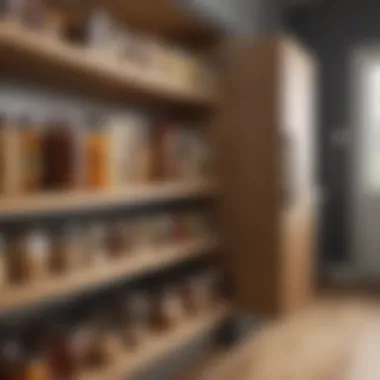

The goal should be to select a cabinet that enhances the kitchen’s aesthetics without sacrificing usability. What’s more, syncing style with function can elevate your entire cooking experience, making it enjoyable rather than a chore.
"A well-designed pantry cabinet not only organizes your cooking essentials but takes the aesthetic of your kitchen up a notch!"
In summary, taking the time to assess your space, set a budget, and harmonize style with functionality paves the way for making a well-informed decision on choosing the right single pantry cabinet.
Installation Considerations
When it comes to adding a single pantry cabinet to your kitchen, installation matters greatly. It can make the difference between a storage solution that works well and one that feels out of place or even causes issues like jamming. Knowing what’s involved in this process helps eliminate confusion down the line, ensuring your cabinet not only looks good but functions flawlessly.
Do-It-Yourself vs. Professional Help
The choice between a do-it-yourself method or hiring professionals can be daunting. On one hand, opting for a DIY installation might provide a sense of achievement. You might have the tools and drive to tackle the job by yourself. However, it’s crucial to evaluate your skill level and the complexity of the cabinet you’ve chosen.
For simpler cabinets or if you already have experience with installations, a DIY approach could save you money and time. Yet, if you feel uncertain, it’s wise to consider hiring a professional. They can help avoid potential pitfalls, such as improper mounting that could lead to instability.
Ultimately, weigh the cost of potential mistakes against the savings of not hiring someone. It’s better to err on the side of caution than to face repairs later. Here’s a quick checklist:
- Assess your skills honestly
- Consider the cabinet’s complexity
- Factor in time versus cost
- Evaluate if you have the necessary tools
Tools Required for Installation
Should you decide to take the plunge and install the pantry cabinet yourself, having the right tools on hand is essential. You’ll want a mix of staples and perhaps some specialty items. Here’s a list that covers the basics:
- Measuring tape: To ensure everything fits like a glove.
- Level: Important for making sure your cabinet isn't leaning or uneven.
- Drill: For driving screws and assembling parts.
- Screwdriver: A must for tightening and adjusting your setup.
- Stud finder: If you’re mounting a heavy cabinet, you’ll want to secure it to wall studs for stability.
- Safety goggles: Always a good idea to protect your eyes while working.
- Wood glue: Additional support for assembling furniture can never hurt.
Having these items at the ready can save you a lot of last-minute trips to the hardware store.
Mounting and Stability
Mounting a single pantry cabinet properly is critical for avoiding issues later on. The first step is to make sure the wall can support the weight of the cabinet and its contents. Ensure you find the studs in the wall and secure your cabinet there. This will enhance the stability and prevent it from falling or shifting over time.
Here are some key points to remember for a stable installation:
- Weight Distribution: Ensure heavier items are stored on lower shelves. This keeps the center of gravity low, making the cabinet less likely to tip.
- Use Anchors If Needed: If you’re unable to locate studs, use wall anchors to provide extra support for your screws.
- Frequent Checking: Once installed, it’s a good habit to check the cabinet periodically to ensure it has remained secure.
Stability is key not just for maximizing your pantry's function but also for ensuring safety in your kitchen space.
"An ounce of prevention is worth a pound of cure."
Following proper installation steps can save you headaches in the future.
By understanding installation considerations, you’re better prepared to create a pantry setup that meets your needs flawlessly.
Styling Your Single Pantry Cabinet
Styling your single pantry cabinet isn’t just about making it look good; it's about creating a space that reflects your personality while being functional. When you think of a pantry, it often conjures images of a storage space filled with cans and packets, but with a little creativity, it can become a highlight of your kitchen, adding character and coherence to your decor.
One primary consideration is the color scheme. The colors you choose can greatly influence the mood of the kitchen. Bright whites or soft pastels can evoke feelings of freshness and cleanliness, making it a vibrant working space. On the other hand, deep tones like navy or forest green can give a sophisticated and cozy vibe, perfect for a rustic or modern style. Finishes also play a critical role. Glossy finishes can be appealing, yet they require more maintenance, while matte finishes can offer durability and a unique tactile quality.
Color Schemes and Finishes
Selecting the right color schemes and finishes for your pantry cabinet is akin to choosing an outfit. The two must not only compliment each other but also match your style. Consider what you want to express through color.
- Neutral Colors: These provide a classic backdrop that can easily be accessorized with decorative elements or colorful containers. Think grays, beiges, or whites.
- Bold Colors: If you’re feeling adventurous, incorporate shades like burgundy or teal, making the pantry stand out.
When it comes to finishes, matte paints can disguise fingerprints and smudges, while glossy ones can make the space look larger. Another trendy option is using wood. Natural wood not only adds warmth but can be stained to match any shade.
Incorporating Decorative Elements
To elevate the aesthetic of your pantry, decorative elements are a must. Adding personal touches can turn a simple cabinet into a conversation starter. Here are some ideas:
- Stylish Containers: Using glass jars or woven baskets can create an organized but visually appealing display. Consider labeling them for a sleek, uniform look.
- Art: Depending on the door space, a framed picture or a small shelf for potted herbs adds life. Art is not just for walls, so consider perhaps a small canvas or an arrangement of cookbooks.
- Lighting: Installing LED strip lights on the shelf undersides or inside the cabinets can create a dramatic effect at night, enhancing visibility and ambiance.
"A pantry cabinet isn't just for storage; it's an expression of style and taste."
Creating a Cohesive Look with Surrounding Decor
To achieve a unified appearance in your kitchen, cohesion in styling is key. Your single pantry cabinet needs to harmonize with the surrounding decor to avoid a disjointed look. Consider these elements to align your cabinet’s style:
- Consistent Materials: If your kitchen cabinets are a matte finish, it’s wise to choose a similar finish for your pantry to avoid clashing textures.
- Color Palette: Stick to a defined color palette throughout your kitchen. This doesn’t mean everything must match; rather, the hues should complement each other to create a coherent visual flow.
- Functional Decor Pieces: Think about including a decorative cutting board or an eye-catching fruit bowl on your pantry cabinet. These can serve a purpose while enhancing the overall design.
Maintenance Tips for Longevity
Maintaining a single pantry cabinet is not about the aesthetics alone; it plays a pivotal role in ensuring the cabinet's functionality over time. Whether your pantry is a sleek contemporary piece or a handcrafted rustic wonder, regular upkeep can extend its lifespan significantly. Investing a bit of time and effort into maintenance not only enhances durability but also helps in preserving the beauty of your cabinet.
A well-kept pantry cabinet becomes a reliable companion in your kitchen rather than just another piece of furniture. Here are some insights that emphasize the importance of routine maintenance, the benefits of proper care, and considerations to keep in mind.
Routine Cleaning Practices
Keeping your pantry cabinet clean does wonders for its longevity. Dust and residue buildup can diminish its appearance and functionality. Here are a few habits that can help:
- Wipe Down Surfaces Regularly: Use a soft, damp cloth to remove any dust or spills. Avoid abrasive materials that could scratch the finish.
- Use Gentle Cleaners: For areas with stubborn stains, a mixture of warm water and mild soap is usually sufficient. Always check if the cleaner is safe for the material used in your cabinet.
- Empty and Organize Periodically: Every few months, take everything out of the cabinet . This gives you an opportunity to clean the interior and reorganize items. It’s a smart strategy that prevents items from piling up and ensures that items are not forgotten.
Incorporating these steps will not only keep your cabinet looking fresh, it’ll also enhance the function by ensuring that nothing is blocking shelves or drawers.
Dealing with Wear and Tear
Even the sturdiest of cabinets can face some wear over time. Understanding how to effectively manage these issues is crucial. Here are some tips:
- Inspect Regularly: Every so often, take a good look at your pantry. Check for any loose screws or hinges that may need tightening. This proactive approach can prevent bigger issues down the line.
- Repair Minor Dents and Scratches: For minor marks or dents, a wood filler can work wonders. Gently apply it to the affected area and follow with a matching paint or stain.
- Monitor Humidity Levels: High humidity can lead to warping, especially in wood cabinets. Consider using a dehumidifier in your kitchen, if necessary, to keep humidity down.
If you notice significant damage, it may be worth consulting a professional before the problem escalates.
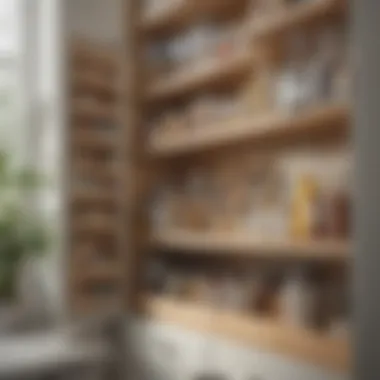

Restoration Techniques for Wood Cabinets
Should the wear really show on your wood pantry cabinet, restoration becomes vital. Here are techniques that can restore it to its former glory:
- Refinishing: Stripping down the old finish and applying a new layer can breathe new life into a tired cabinet. This requires some effort, but the results can be stunning.
- Staining: If you prefer a change in color, consider staining your wood cabinet. This can effectively enhance the wood grain while protecting it from further wear.
- Professional Assessment: If you aren't quite sure how to go about restoration, hiring a professional can save you from unnecessary stress and yield better results.
Pro Tip: Opting for a maintenance plan that includes regular inspections and cleanings can save you time and money in the long run.
Keeping your single pantry cabinet in good shape is more than just looking tidy. It enhances functionality, shows care for your environment, and, let's be honest, makes your kitchen a better place to be. With these maintenance tips in hand, you can ensure that your cabinet will serve you well for many years.
Sustainable Practices in Cabinet Selection
In an era where ecological awareness is gaining momentum, the selection of a single pantry cabinet is often an overlooked aspect in conversations about sustainable living. Environmentally friendly choices not only enhance the aesthetic appeal of the kitchen but also contribute to a positive impact on the planet. This section delves into why sustainable practices matter in cabinet selection and explores the nuances involved in making eco-conscious choices.
Understanding Eco-Friendly Materials
When considering a pantry cabinet, the materials used play a pivotal role in its environmental footprint. Many cabinets on the market today are constructed from various forms of wood, particleboard, or even metal. However, not all materials are created equal. Opting for solid wood, especially if sourced from sustainable forests, is a choice laden with benefits. This guarantees durability and minimizes waste, as these cabinets can serve you well for many years.
Moreover, bamboo has emerged as a popular eco-friendly alternative. It grows quickly and can be harvested without causing long-term damage to the ecosystem. Here are some eco-friendly materials to consider:
- Reclaimed Wood: Using salvaged lumber not only prevents waste but also adds unique character to your cabinet.
- Low-VOC Finishes: Volatile organic compounds (VOCs) are harmful chemicals that can leach into the air. Look for finishes that are low in VOCs, ensuring a healthier indoor atmosphere.
- Plywood from Sustainable Sources: If solid wood isn't feasible, look at high-quality plywood that is certified to meet environmental standards.
Sourcing Ethically Produced Cabinets
Once environmentally friendly materials are identified, the next step is finding cabinets that are ethically produced. This involves looking at the manufacturing processes and the companies involved in the sourcing of materials. Many brands now emphasize sustainability, but it pays to dig deeper.
Here are steps to ensure that you are sourcing responsibly:
- Research Brands: Investigate companies' sustainability practices through their websites or product information.
- Certifications Matter: Look for certifications such as Forest Stewardship Council (FSC) or Greenguard, which indicate commitment to eco-friendly practices.
- Local Production: Supporting local manufacturers not only reduces carbon footprints due to transportation but often promotes better labor practices.
- Ask Questions: Don’t hesitate to ask manufacturers about their sourcing policies and ethical standards for labor.
Embracing sustainable practices in cabinet selection is not just a personal preference; it reflects a broader commitment to protecting the environment for future generations.
The journey towards selecting an eco-friendly pantry cabinet might seem daunting at first, but with attention to materials and ethics, you can make choices that resonate with greater meaning. This conscious approach not only forms a healthier home environment, but it also fosters a culture of responsibility, all while enhancing the elegance of your space.
Popular Brands and Options
When it comes to selecting a single pantry cabinet, the plethora of brands and options available is crucial for understanding what suits your needs best. This section explores not only the notable brands that lead the market but also delves into how their offerings can impact your kitchen's functionality and aesthetics. Choosing the right pantry cabinet brand is not merely about reputation but also about quality, variety, and the adaptability of the products offered. Let's dig into two main categories: high-end choices and affordable alternatives.
High-End Choices
High-end pantry cabinets often epitomize quality and craftsmanship. Brands like California Closets and IKEA (the latter in its more premium range) provide exceptional designs that align both with luxury living and practical needs. Their cabinets are usually made from durable materials, robust enough to withstand the wear and tear common in busy kitchens.
- Customization Options: Many high-end brands offer extensive customization. You can select finishes, hardware, and even internal layouts that fit your specific requirements.
- Superior Durability: Investing in premium cabinets can lead to significant long-term savings. Their resilience to warping and fading often means they won't need replacement as frequently as cheaper alternatives.
- Aesthetic Appeal: High-end cabinets often come with exquisite designs. Shades and textures that can suit both modern and traditional kitchen interiors elevate your space and can serve as a conversation starter.
Among the leading brands, Schmidt is known for their cutting-edge design and innovative use of space, making them a top choice for the discerning homeowner who values both style and functionality.
Affordable Alternatives
Not everyone has an expansive budget to work with, and that’s perfectly alright. There are many affordable brands that don’t compromise on quality or design. Home Depot and Wayfair have budget-friendly pantry cabinets that cater to a wide audience.
- Value for Money: These cabinets are often manufactured to handle typical kitchen needs without breaking the bank. While they may not offer as many customizations as their high-end counterparts, they still provide satisfactory solutions.
- Ease of Accessibility: Affordable options are often more accessible in terms of availability and shipping. You can find options that suit your immediate needs without a long lead time.
- Smart Design Features: Many budget brands incorporate smart design tactics, such as adjustable shelving, to help maximize space even if the price tag is lower.
Furthermore, brands like Sauder often present an excellent balance between price and quality, providing designs that enhance functionality without the hefty price tag.
Choosing the right pantry cabinet goes beyond just visuals; it’s about enhancing your home’s efficiency and storage capabilities.
Customization Opportunities
Customization of single pantry cabinets is not just a trendy choice; it’s about crafting a space that truly reflects the homeowner's needs and style. This possibility of personalization allows individuals to blend functionality with aesthetics, ensuring that the pantry cabinet is not merely a storage unit but also an integral aspect of the kitchen’s overall design.
When discussing customization opportunities, it is vital to consider various elements that can significantly enhance both the utility and appeal of a single pantry cabinet. From choosing the materials to adjusting the layout, these elements play a crucial role in achieving a tailored solution that meets personal requirements and enhances the home’s overall look.
Tailored Solutions for Unique Spaces
Tailoring a single pantry cabinet to fit unique spaces can bring about a significant transformation. Each kitchen has its layout, dimensions, and design language. A customizable pantry cabinet allows for an effective use of otherwise wasted spaces, like corners or very small nooks. For example, employing a pull-out pantry can utilize narrow spaces that traditional cabinets cannot accommodate much effectively.
Some tailored solutions include:
- Corner cabinets: Using lazy Susans or other mechanisms to maximize accessibility.
- Pull-out shelves: These are perfect for deep cabinets, allowing for easier access to items at the back.
- Vertical dividers: Helpful for organizing baking sheets or cutting boards vertically, making them more accessible.
By carefully considering these options, homeowners can create pantry cabinets that not only hold items but also simplify their daily activities. Additionally, speaking volumes about personal style—be it sleek, modern finishes or rustic wood—can turn a simple cabinet into a breathtaking focal point.
Working with Designers and Craftsmen
When embarking on the journey of customizing a pantry cabinet, involving designers and craftsmen can make a world of difference. Professionals bring expertise and a keen eye, ensuring that every choice made—from design to materials—aligns with the homeowner's vision. Collaborating with these experts can also help prevent common pitfalls, such as underestimating the need for certain features or overlooking essential design aspects.
Here are some considerations while working with designers and craftsmen:
- Effective communication: Clearly express your vision and requirements. Providing sketches or photos of inspiration can pave the way for productive conversations.
- Feasibility: While creativity is vital, ensure that the proposed designs adhere to local building codes and practical limitations of your space.
- Budget constraints: Discussing your budget early on can help steer the design process, ensuring options remain practical.
Epilogue
The conclusion serves as the final touchstone for understanding the immense value a single pantry cabinet brings into a home. Through this guide, it has become clear that these cabinets aren’t just furniture; they are vital components of a well-organized and functional kitchen. Homeowners, interior designers, decorators, and renovators will find themselves appreciating the depth of options available.
Recap of Key Points
It’s important to reiterate the standout elements covered:
- Versatility: The single pantry cabinet can adapt to various kitchen styles, whether modern, traditional, or rustic.
- Functionality: With multiple storage solutions, adjustable shelves, and customization options, these cabinets maximize space efficiently.
- Materials: Different materials such as wood, metal, and composites bring distinct advantages, balancing durability with aesthetic appeal.
- Installation: An understanding of installation methods aids in ensuring stability and longevity.
- Sustainability: Choosing eco-friendly materials contributes to a healthier environment.
This clarity helps homeowners make informed choices that can enhance their living spaces, ensuring their kitchens are not only functional but also well-designed.
Future Trends in Pantry Cabinets
The landscape of pantry design is always evolving. As homeowners grow increasingly aware of their environment and functionality, several trends emerge:
- Smart Technology: Integration of smart devices that help in inventory management and kitchen organization is becoming popular. Cabinets boasting built-in features to track the contents can facilitate a smoother cooking experience.
- Open Shelving: There’s a shift toward open concepts, allowing for easy access and display of pantry contents, appealing to modern design ideals.
- Sustainable Materials: Future cabinets will likely embrace even more eco-friendly materials as the call for sustainability grows louder. This includes options made from recycled wood or rapidly renewable resources.
- Customization: Homeowners are looking for unique solutions that reflect their personal style, so custom cabinetry will become more sought after, ensuring spaces feel individualized and cohesive.
In wrapping up this guide, it’s evident that the single pantry cabinet stands as a critical piece in the puzzle of kitchen organization. Its multifaceted nature ensures that it caters to various needs and styles, living up to the demands of modern-day living.



